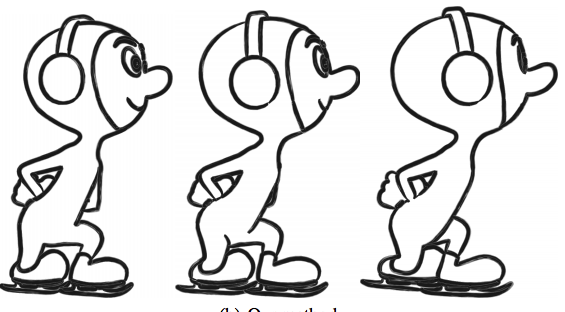
 |
 |
Computing Smooth Surface Contours with Accurate Topology Pierre Benard, Aaron Hertzmann, Michael Kass March 2014 This paper introduces a method for accurately computing the visible contours of a smooth 3D surface for stylization. This is a surprisingly difficult problem, and previous methods are prone to topological errors, such as gaps in the outline. Our approach is to generate, for each viewpoint, a new triangle mesh with contours that are topologically-equivalent ... [more] To appear in ACM Transactions on Graphics |
 |
Stylizing Animation By Example Pierre Benard, Forrester Cole, Michael Kass, Igor Mordatch, James Hegarty, Martin Sebastian Senn, Kurt Fleischer, Davide Pesare, Katherine Breeden April 2013 Skilled artists, using traditional media or modern computer painting tools, can create a variety of expressive styles that are very appealing in still images, but have been unsuitable for animation. The key difficulty is that existing techniques lack adequate temporal coherence to animate these styles effectively. Here we augment the ... [more] Additional materials: [ComputerGraphicsWorldArticle.pdf], [PaintTweenDistro.tgz], [PaintTweenWorkingSets.tgz], [additionalResults.mov], [mainVideo.mov] Available in the proceedings of SIGGRAPH 2013. Available as Pixar Technical Memo #13-03 |
 |
Coherent Noise for Non-Photorealistic Rendering Michael Kass, Davide Pesare July 2011 A wide variety of non-photorealistic rendering techniques make use of random variation in the placement or appearance of primitives. In order to avoid the "shower-door" effect, this random variation should move with the objects in the scene. Here we present coherent noise tailored to this purpose. We compute the coherent ... [more] Available in the Proceedings of SIGGRAPH 2011 |
 |
Smoothed Local Histogram Filters Michael Kass, Justin Solomon May 2010 Local image histograms contain a great deal of information useful for applications in computer graphics, computer vision and computational photography. Making use of that information has been challenging because of the expense of computing histogram properties over large neighborhoods. Efficient algorithms exist for some specific computations like the bilateral filter, but not others. ... [more] To appear in the Proceedings of SIGGRAPH 2010 Available as Pixar Technical Memo #10-02 |
 |
Animating Oscillatory Motion With Overlap: Wiggly Splines Michael Kass, John Anderson June 2008 Oscillatory motion is ubiquitous in computer graphics, yet existing animation techniques are ill-suited to its authoring. We introduce a new type of spline for this purpose, known as a ``Wiggly Spline.'' The spline generalizes traditional piecewise cubics when its resonance and damping are set to zero, but creates oscillatory animation when its resonance and damping ... [more] Available in SIGGRAPH 2008 Available as Pixar Technical Memo #06-06a Other versions: |
 |
Interactive Depth of Field Michael Kass, Aaron Lefohn, John Owens January 2006 Accurate computation of depth-of-field effects in computer graphics rendering is generally very time consuming, creating a problematic workflow for film authoring. The computation is particularly challenging because it depends on large-scale spatially-varying filtering that must accurately respect complex boundaries. Here we introduce an approximate depth-of-field computation that is good enough for film preview, yet ... [more] Additional materials: [movie.avi] Available as Pixar Technical Memo #06-01 |
 |
Untangling Cloth David Baraff, Andrew Witkin, Michael Kass August 2003 Deficient cloth-to-cloth collision response is the most serious shortcoming of most cloth simulation systems. Past approaches to cloth-cloth collision have used history to decide wheter nearby cloth regions have interpenetrated. The biggest pitfall of history-based methods is that an error anywhere along the way can give rise to persistent tangles...This ... [more] Available in the Proceedings of SIGGRAPH 2003 |
 |
Subdivision Surfaces in Character Animation Tony DeRose, Michael Kass, Tien Truong August 1998 The creation of believable and endearing characters in computer graphics presents a number of technical challenges, including the modeling, animation and rendering of complex shapes such as heads, hands, and clothing. Traditionally, these shapes have been modeled ... [more] Available in the Proceedings of SIGGRAPH 1998. |